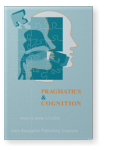Vol. 26:2/3 (2019) ► pp.197–214
The Wheel of Time
The relationship between religious experiences and Chinese Buddhists’ spatial representations of time
Previous research suggests that both patterns in orthography and cultural-specific associations of space-time affect how people map space onto time. In the current study, we focused on Chinese Buddhists, an understudied population, investigating how religious experiences influence their mental representations of time. Results showed that Chinese Buddhists could represent time spatially corresponding to left-to-right, right-to-left and top-to-bottom orientations in their religious scripts. Specifically, they associated earlier events with the starting point of the reading and later times with the endpoint. We also found that Chinese Buddhists were more likely to represent time in a clockwise way than Chinese atheists. This is because Buddhism regards time as cyclic and consisting of repeating ages (i.e. Wheel of Time). Taken together, we provide first psychological evidence that Chinese Buddhists’ spatial representations of time are different from atheists’, due to their religious experiences, namely, both the reading direction in Buddhist texts and Buddhist concepts of time.
Article outline
- 1.Introduction
- 2.Method
- 2.1Participants
- 2.2Materials
- 2.3Procedure
- 2.4Results and discussion
- 3.General discussion
- 4.Conclusion
-
References
